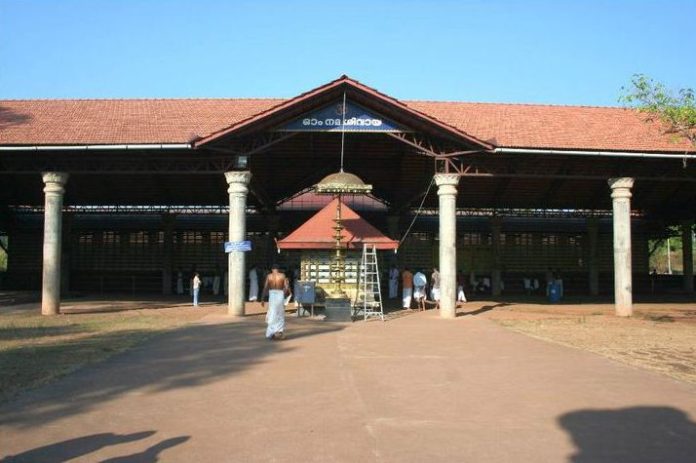The Rajarajeshwara Temple, nestled in the enchanting town of Taliparamba in Kerala’s Kannur district, stands as a testament to the profound religious heritage of South India. This ancient shrine, dedicated to Lord Shiva, holds a revered position amongst the 108 historic Shiva Temples of Kerala and is a celebrated landmark in the rich tapestry of South Indian temple architecture. Its towering shikhara, weighing an astounding 90 tonnes, once reigned as the tallest among its contemporaries, and its significance extends beyond mere physical grandeur.
This temple, known as the Rajarajeshwara Temple, not only serves as a place of worship but also as a sanctuary of solace and guidance for devotees encountering life’s challenges. Through the ages, it has been the focal point of spiritual devotion and a repository of ancient wisdom. According to legend, this sacred abode was meticulously restored by the venerable Sage Parashurama in a bygone era, long before the advent of the Kali Yuga, marking its enduring spiritual importance.
Legends:
The temple is among the 108 ancient Shiva temples in Kerala, each with its unique legend and spiritual significance. It holds a place of equal reverence alongside other prominent Shiva temples in the region, such as Vaikom, Ettumanur, and Trichur.
Taliparamba is also believed to be an ancient Shakti Peetham, and its legend is entwined with the story of Goddess Sati, the wife of Lord Shiva. It is said that after Sati’s self-immolation and the ensuing tandavam (divine dance of destruction) by Lord Shiva, her head fell at this very spot. This tale is connected to her father, Daksha, a respected Hindu king who harbored a disregard for Lord Shiva.
The temple houses a Shiva Linga that is believed to be several millennia old. Legend has it that Lord Shiva presented 13 sacred Shivalingas to Goddess Parvati (Sati) for worship. One of these lingas was gifted to a sage named Maandhata, who received it after intense prayers. Lord Shiva instructed that the lingam should only be installed in a place free from cremation grounds. After an extensive search, Maandhata found Taliparamba to be the holiest site and installed the Shiva Linga there. However, upon his death, the linga disappeared into the earth. Similar events occurred with two other kings, Muchukundam and Shathasoman, who received Shivalingas from the goddess. The third linga was eventually installed in the present temple, and according to some legends, it is considered a ‘Jyotirlingam.’
Another significant legend associated with the temple involves the visit of the Puranic sage Parashurama, an incarnation of Lord Vishnu. He encountered an ancient shrine here, in a state of disrepair, and was deeply moved by its spiritual potential. Sage Narada then narrated the temple’s story to Parashurama. According to this legend, the sons of Lord Brahma, including sage Sanaka, churned the Sun’s disk to mitigate its fierce heat. They mixed the resulting dust with the divine nectar of immortality, Amrita, and formed three sacred Shivalingams. These lingams were presented to Goddess Parvathi, who in turn gave them to three kings during different Yugas (ages). Maandhata, Muchukundam, and Shathasoman were the recipients. Each king was instructed to install the lingams where no death had occurred or dead bodies had fallen. After extensive searches, they all arrived at the same spot in Taliparamba. Maandhata installed the first Shivalingam at this location, which came to be known as Taliparamba, meaning “place large enough to accommodate a Thalika” (a plate).
Over time, the first Jyotirlingam disappeared into the earth with the conclusion of the Treta Yuga. In the Dvapara Yuga, King Muchukundam received the second lingam from Goddess Parvathi and also installed it at the same spot. This lingam too dissolved into the earth. Finally, King Shathasoman, who received the third Shivalingam, faced a similar situation. However, with the intervention of Sage Agastya, who prostrated before the lingam twelve and a half times, the lingam became firmly fixed in the ground. Thus, this sacred spot became spiritually vibrant threefold.
History:
Inspired by the profound spiritual energy and legends surrounding the temple, Sage Parashurama decided to renovate it for the welfare of humanity. To carry out this restoration, he enlisted the celestial architect Ari Vishwakarma.
During the final phase of the temple’s renovation, Sage Agastya made an appearance. He performed an abhishekam (ablution) on the temple’s deity and lit a ghee lamp, which has since burned continuously with a regular supply of ghee.
Offering ghee in gold, silver, and copper pitchers with utmost devotion remains an essential part of worship at the temple.
Legend has it that even Lord Rama, on his victorious return from Lanka, stopped at the temple to offer worship to Lord Shiva. In honor of this divine presence, devotees are still not allowed into the namaskara mandapam (hall for paying respects) to this day.
Architecture
The Rajarajeshwara Temple in Taliparamba is a stunning example of Kerala temple architecture, showcasing majestic proportions and intricate detailing. Its sanctum sanctorum, at the heart of the temple, epitomizes this architectural style. This two-tiered, rectangular structure features an exquisite copper-sheeted roof that gracefully tapers to a resplendent gold Kalasham, creating a visually captivating sight. The temple has four entrances, with devotees granted access through the eastern and southern doors. The eastern entrance leads to the divine presence of Lord Rajarajeshwara, symbolized by a majestic Jyothirlingam, the central object of devotion. Ghee lamps delicately dangle on either side of the Jyothirlingam, casting a divine glow, with the Bhadradeepam, illuminated by the revered sage Agastya, radiating a prominent flame. Rows of silver nilavilakku, or ghee lamps, line the floor, enhancing the temple’s spiritual ambiance. The Jyothirlingam itself is adorned with sacred insignia, including the thrinethrams (three eyes), a crescent moon, and the Nagaphanam (serpent symbol). Above it, a golden Prabha (halo) and a Vyaalimukham, the visage of a mythical being, enhance the temple’s architectural grandeur. Devotees can have a direct sight of the Jyothirlingam at specific times during the day, adding to the temple’s spiritual significance. Beyond the sanctum sanctorum, the temple complex houses shrines dedicated to Lord Dakshinamoorthi, Lord Ganesha, and Lord Subrahmanya, further enriching the temple’s architectural and spiritual diversity. This architectural splendor not only reflects the dedication and craftsmanship of its creators but also stands as a timeless testament to the spiritual opulence of Kerala’s temple heritage.
Festivals and cultural significance
The Rajarajeshwara Temple holds a profound cultural significance that extends far beyond its role as a spiritual center. It serves as a vibrant cultural epicenter that deeply influences the socio-cultural fabric of Kannur and the wider region of Kerala. The temple is intricately woven into the lives of the local community, fostering unity, spiritual enrichment, and the preservation of cultural traditions.
A cornerstone of the temple’s cultural importance lies in its close association with Theyyam, an ancient ritual dance form originating in northern Kerala. The temple serves as a primary venue for Theyyam performances, making it a vital guardian and promoter of this traditional folk art. During the temple’s annual festivals, Theyyam performances take center stage, showcasing an array of characters and stories from local myths and legends.
The temple calendar is punctuated by several vibrant celebrations that illuminate its cultural richness. Foremost among them is the Shivaratri Festival, a grand event dedicated to Lord Shiva. Celebrated annually in the month of Kumbham (February-March), this festival draws devotees who participate in night-long vigils, ritual dances, and hymn recitations. Special poojas (rituals) and ceremonies are conducted, and the entire temple complex is infused with spiritual fervor.
Another significant festival is the Prathishta Dinam or Installation Day, commemorating the day when the deity was consecrated in the temple. This occasion is marked with elaborate rituals, cultural performances, and the distribution of Prasadam (blessed food) to devotees.
In addition to these major festivals, celebrations such as Navaratri, dedicated to the Goddess Durga, and Vinayaka Chaturthi, honoring Lord Ganesha, are observed with great pomp and grandeur. These festivities not only reaffirm the religious beliefs of the devotees but also provide a platform for local artists to showcase their talents, reinforcing the temple’s role as a promoter of local arts and culture.
Temple Timings
The Rajarajeshwara Temple in Taliparamba is open from 5 AM to 12 noon and from 5 PM to 8:30 PM, providing devotees and visitors with specific hours for worship and spiritual activities.
How to reach the Rajarajeshwara Temple, Taliparamba, Kerala
The Rajarajeshwara Temple in Taliparamba, Kerala, is well-connected and can be reached by various modes of transportation:
By Air: The nearest airport to Taliparamba is Kannur International Airport, located approximately 35 kilometers away. From the airport, you can hire a taxi or take a bus to reach the temple.
By Train: The nearest railway station is Kannur Railway Station, which is about 25 kilometers from Taliparamba. Kannur is well-connected to major cities in India. From the railway station, you can hire a taxi or take a local bus to reach the temple.
By Road: Taliparamba is well-connected by road to various cities and towns in Kerala. You can reach Taliparamba by private car, taxi, or by taking a bus from nearby towns. The temple is located in the heart of Taliparamba town, so it is easily accessible once you reach the town.























































